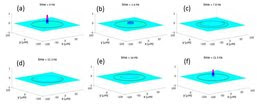May 12, 2016
WASHINGTON — Researchers have developed a promising new fiber-optic based chemical sensing method that uses light inside a fiber to induce sound waves outside it, providing indirect information about what surrounds the fiber. By overcoming a significant limitation of existing sensors, the new method could improve sensing capabilities for a wide range of applications, including industrial processes and remote detection of chemicals.
“A fundamental restriction that makes sensing of chemicals very difficult is that we must have overlap between light and the substance being measured,” said Avi Zadok, Faculty of Engineering and Institute of Nano-Technology, Bar-Ilan University, Israel, who led the research team together with graduate student Yair Antman. “This limitation has been holding us back for many, many years in fiber sensors.”
The researchers demonstrate their fundamentally new sensing method in The Optical Society's journal for high impact research, Optica. “We employ the interrelations between light and sound, and use sound as our messenger to the outside world," Zadok said.
Overcoming a contradiction
Optical fibers are convenient for chemical sensing because they are very small, can be used remotely — they are capable of measuring chemicals even tens of kilometers away — and can be installed almost anywhere, including hazardous environments such as oil wells where electricity can’t be used. However, existing fiber-optic sensing technologies require the light inside of the fiber to contact the substance being measured, which contradicts what optical fibers are designed to do: make sure that no light escapes.
Previously, working around this contradiction required drastic modifications such as drilling holes in the fiber or etching it down to a very thin diameter to force the light to come out. “While you can get fantastic sensitivities in these approaches, the fact that you have to go through these modifications makes it more difficult to produce these sensors and also affects their robustness,” said Zadok.
Rather than using light directly, Antman came up with the idea to use light transmitted through optical fibers to create sound waves, or acoustic vibrations, taking advantage of a phenomenon known as stimulated Brillouin scattering.
Although stimulated Brillouin scattering is used in commercial fiber sensors today, existing sensors keep both the light and the sound waves inside the fiber. “The critical step was to look for certain mechanical behaviors that do reach outside the fiber, and take advantage of those,” said Zadok. “We found that stimulated Brillouin scattering in a forward direction could be used to provide information about what is outside of the fiber.”
The new approach works by using optical waves that are intense enough to create an acoustic vibration that reaches outside of the fiber. These vibrations gradually decay based on properties of the substance that surrounds the fiber, providing an indirect method of sensing the chemical content of the environment. Because the light remains inside the fiber, the technique allows the use of a traditional optical fiber with no structural modifications, and the researchers only had to remove the fiber’s protective plastic coating.
Testing the new technique
The researchers demonstrated their new technique in ethanol and deionized water, taking acoustic impedance measurements, which provide information about a liquid’s density and the speed of sound wave traveling through the liquid. Results reproduced known values with 1 percent precision. They also successfully distinguished between water samples with different levels of salinity.
The technique might one day be useful for monitoring the desalinization of water, or electro-chemistry processes such as in fuel cells, or for detecting changes in the concentrations of ions or dissolved salts used in industrial chemical processes.
It might also be possible to adapt the new technique to detect specific chemicals. By treating the outer surface in a way that would attract the chemical of interest, the researchers theorize that the acoustic waves would be modified in a detectable way when the target chemical attaches to the fiber. Although further development and testing are needed, such an approach, if successful, could be useful for detecting explosives or certain pathogens.
“Although we would like to explore applications in the future, for this work we were more focused on solving an open problem that seemed like a paradox: You cannot be inside the fiber and outside the fiber at the same time,” said Zadok. “We found a way around it.”
Paper: Y. Antman, A. Clain, Y. London, A. Zadok, "Optomechanical sensing of liquids outside standard fiber using forward stimulated Brillouin scattering," Optica, 3, 5, 510 (2016).DOI:http://dx.doi.org/10.1364/OPTICA.3.000510













